Choosing the Right Power Supply Size for Your Gaming PC


Intro
When it comes to building or upgrading a gaming PC, the choice of the power supply unit (PSU) often doesn't get the spotlight it deserves. For many tech enthusiasts and gamers, the thrill usually revolves around the powerful graphics cards or the state-of-the-art CPUs. However, skipping over the PSU can lead you into choppy waters, as a poorly selected unit can prevent your components from performing at their best or, worse, lead to hardware failures.
Understanding how to determine the appropriate size of a power supply is just as significant as picking the latest GPU. The right PSU connects the dots between your components, providing them with the energy they need while ensuring long-term stability. A comprehensive grasp of wattage requirements, efficiency ratings, and potential future upgrades become paramount in this journey.
This section will shed light on the fundamental role of a PSU and why selecting the correct wattage is pivotal not only for now but also for keeping pace with technological advancements in the gaming world.
Understanding Power Supply Units
When diving into the world of gaming PCs, understanding power supply units (PSUs) is non-negotiable. The PSU acts like the heart of your system, pumping energy to all components. Without a proper power supply, the best gaming rig can falter, leading to performance glitches or even hardware failures. The importance of selecting the right PSU cannot be overstated, as it affects not just the immediate functionality of your build, but also its long-term reliability and efficiency.
The key elements of a PSU include its wattage rating, efficiency, and the types of cables it employs to distribute power. Choosing a power supply that aligns well with your system’s needs not only ensures stability but also enhances the overall experience while playing demanding games or engaging in resource-intensive tasks. Additionally, a reliable power supply keeps your components safe from erratic voltage fluctuations.
Definition and Function
A power supply unit is primarily responsible for converting the electrical energy from your wall outlet into a form that your computer components can use. This process isn’t just a straightforward plug and play; it requires the PSU to manage various outputs, handle voltage regulation, and ensure that each piece of hardware gets the right amount of power.
In essence, PSUs have a couple of fundamental functions:
- Voltage conversion: It's tasked with transforming the high-voltage AC from your outlet into lower-voltage DC needed by the different components—like your CPU and GPU.
- Power distribution: A PSU not just transforms, it must also effectively deliver power across multiple rails to ensure every component operates smoothly.
Types of Power Supply Units
Power supply units come in various types, each offering unique features. Understanding these categories can guide you toward making an informed choice that fits your system needs.
Modular PSUs
Modular PSUs are like the Swiss Army knives of power supplies. The unique feature here is that they allow you to connect only the cables you need. This not only minimizes clutter and improves airflow within your case, but also simplifies upgrades. For gamers and enthusiasts who frequently tinker with their setups, modular designs offer flexibility and cleanliness.
The key characteristic of modular PSUs is their customizability. Since users can choose which cables to connect, they make cable management easier, which can contribute to better cooling and system performance.
However, one should note that they are typically more expensive than non-modular options. So while they offer superior handling experience, the budget is a consideration.
Non-Modular PSUs
Non-modular PSUs, on the other hand, come with all cables permanently attached. While this can be a simpler option—less assembly is required—the major drawback lies in the mess of unused cables inside your case. If you're building a rig where aesthetics and airflow are paramount, this characteristic could be a downside.
Despite this, non-modular PSUs can often be found at more attractive price points. They are typically seen as reliable choices for budget builds where aesthetics aren’t the primary concern. Plug and play is the name of the game here, making them approachable for beginners.
Hybrid PSUs
Hybrid PSUs offer a blend of the best of both worlds. They combine features of both modular and non-modular designs, allowing for some cables to be fixed while others remain detachable. This flexibility is appealing for users who want some degree of personalizability in their builds without going all-in on a fully modular system.
The standout feature of hybrid PSUs is the flexibility they offer. Users can choose to have a cleaner look by detaching certain cables while still benefiting from lower costs that come with fixed cables.
However, hybrid systems might not satisfy the most demanding users who crave complete control over every aspect of their setups. Still, many find them a well-rounded option.
"The power supply is the unsung hero of the PC. It deserves as much thought as performance components."
Understanding the types of PSUs empowers you to make a better-informed decision. Each type plays a crucial role in how well your gaming PC performs, and recognizing their strengths and weaknesses contributes to the overall success of your build.
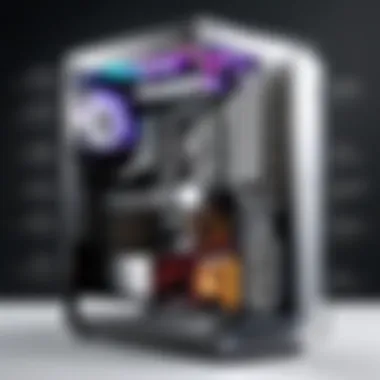
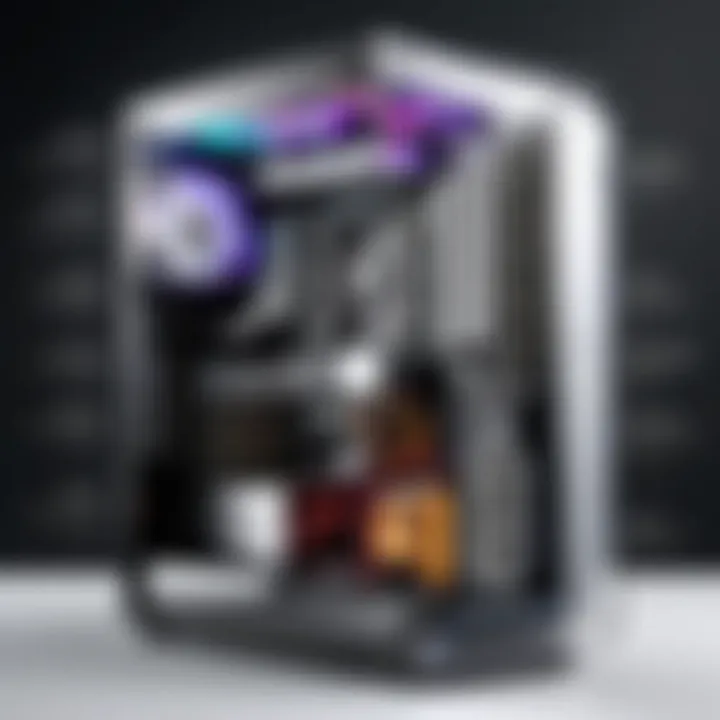
Component Power Requirements
Understanding the power requirements of individual components is a cornerstone in determining the right power supply size for your gaming PC. Each part of your setup has specific energy needs, and knowing these not only helps in selecting a compatible PSU but also ensures stability and performance. Ignoring or underestimating these requirements can lead to an unstable system, crashes, or even hardware failure, which can cost you dearly in both time and money. Additionally, successful component power management can sometimes extend the lifespan of your equipment by preventing overheating or power surges.
Central Processing Unit (CPU)
Power Consumption Ratings
Power consumption ratings are crucial for knowing how much energy your CPU is likely to use while performing tasks. These ratings are specified by manufacturers and often listed in watts. Most modern CPUs have a TDP (Thermal Design Power) rating that indicates the maximum amount of heat generated under typical operational conditions, which also has a direct correlation with power consumption. An important reason these ratings matter is that a PSU must accommodate not just the CPU's base power needs but also any additional consumption that might happen during peak loads.
This characteristic is particularly beneficial to gamers and tech enthusiasts, as it helps you pick the right PSU that aligns with your performance expectations. One unique feature about power consumption ratings is they can sometimes mislead users; for example, power-hungry variants might have a lower TDP due to more efficient architecture. Hence, knowing the specific consumption profile of your CPU can keep you from misjudging how much power you might need.
Overclocking Considerations
Overclocking offers users a way to push their CPU beyond its standard limits, resulting in better performance—especially in games that are intensive on processing power. However, this can significantly increase the power demand and consequently affect the PSU's capabilities. A key aspect of overclocking considerations relates to the headroom that your power supply must provide; having additional wattage can mean the difference between stable performance and system crashes.
The unique feature of overclocking is that it turns a seemingly stable setup into something much more dynamic, requiring closer attention to power specifications. Therefore, while it can provide powerful benefits, it’s also crucial to understand its implications on your power supply choice. Underestimating this may lead to inadequate power delivery and might also void your CPU warranty if issues arise from inadequate supplying.
Graphics Processing Unit (GPU)
GPU Wattage Calculation
Calculating wattage for the graphics card is typically more complex than other components due to variables like gaming settings, resolutions, and tasks being performed. GPU wattage is determined by looking at the maximum power draw specified by manufacturers, which usually reflects the peak operational consumption under extreme conditions. This aspect is essential in ensuring your entire system can handle high-performance gaming or intensive graphical tasks without overloading the power supply.
A notable characteristic of GPU wattage calculation is that it often incorporates factors beyond just the GPU itself. For instance, if your setup uses a multi-GPU configuration, you’ll need to sum the wattage of each card, making sure your PSU can handle the total draw. On a practical level, understanding these calculations can spare users substantial headaches later on, as inadequate power can lead to system instability.
Impact of Graphics Intensity
The intensity of graphics plays a huge role in determining how much power your GPU will realistically consume during various tasks. For example, running graphically demanding games will cause the GPU to draw power at much higher levels than less demanding applications or idle states. The key takeaway here is that when planning a gaming setup, considering the types of games and workloads you’ll encounter can influence not just the PSU size but also its quality.
A unique feature of understanding graphic intensity is the realization that different settings—like ray tracing versus lower settings—can drastically change the power profile of your GPU. Being informed about this can help you choose a power supply that offers consistent performance across your gaming spectrum, avoiding frustrating jitters during critical moments in gameplay.
Additional Components
Storage Devices
Though often overlooked, storage devices also consume their share of power. Traditional hard drives typically use more power while being spun up compared to solid-state drives, which have a notably lower consumption. Recognizing the power requirements of these components can help complete the picture of your gaming PC’s total power draw.
This consideration is particularly noteworthy, especially if you're aiming for fast loading times or planning an expansive setup with multiple drives. Furthermore, SSDs, being far more efficient, can optimize your total power profile while providing snappier performance for games and applications alike.
Cooling Systems
Cooling systems, whether they be air or closed-loop liquid cooling units, require some attention too. While often seen as secondary components, they are crucial for maintaining a stable operating temperature, hence preventing overheating and ensuring your components are functioning optimally. It's vital to look at the specifications for any fans or pumps, as they will add to the overall power requirement.
A key point here is that, while these systems in isolation may not draw much power, every little bit adds up, potentially tipping you over the edge if your PSU isn’t adequately rated. Understanding how to account for these components can greatly enhance system reliability, especially in demanding gaming environments.
Peripherals
Finally, don’t forget about peripherals like keyboards, mice, and additional displays when calculating power needs. Although their individual consumption is typically low, cumulatively they do contribute to the overall power requirement. A surprising fact is that some high-end gaming mice or RGB peripherals can consume a notable amount of power, particularly when used in conjunction with other devices.
Highlighting peripherals' power consumption, designating a small allowance in your PSU's capacity for these devices can help avoid unforeseen issues. This may seem trivial, but neglecting to account for these items could lead to a poorly optimized system. In short, every component you add has to be factored in to keep your gaming rig running smoothly.
Calculating Total System Wattage
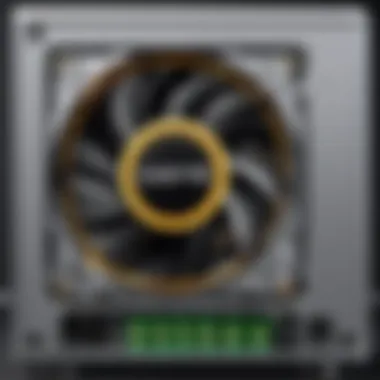
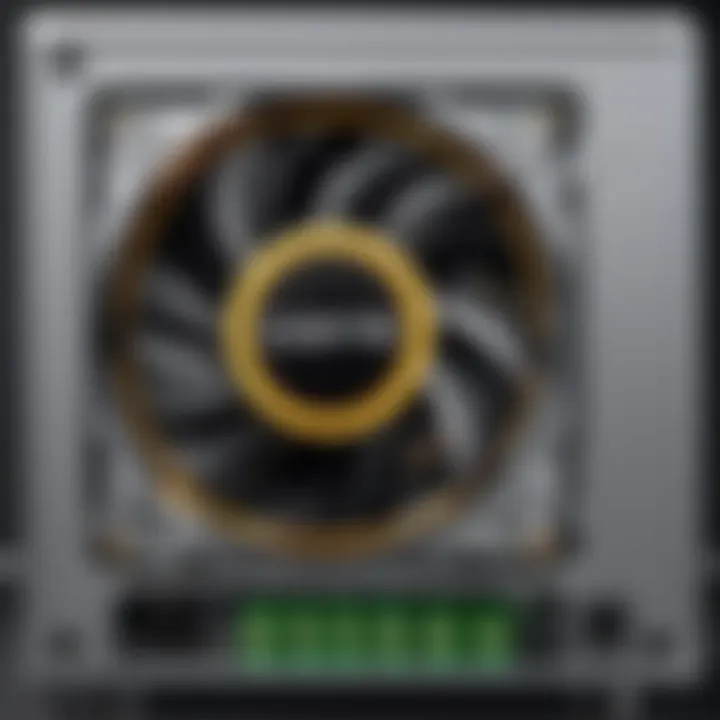
Calculating the total wattage needed for your gaming PC isn't just a simple math game; it’s an essential part of ensuring your build runs smoothly and reliably. Understanding just how much power your system will draw from the wall can save you a heap of trouble later down the road. Too little power can cause crashes or hardware damage, while too much can lead to unnecessary expenses. Therefore, having a solid grip on total system wattage is key to a successful gaming setup.
Gathering Component Specifications
To begin calculating total system wattage, you first need to gather specifications of each component in your build. This includes not only the main parts like the CPU and GPU but also additional hardware. Every component has a power requirement that can be measured in watts.
- Central Processing Unit (CPU): Look up the official power consumption rating of your chosen CPU. This figure, often found on manufacturer's websites, gives you a clear starting point.
- Graphics Processing Unit (GPU): Similarly crucial, the GPU tends to be the power-hungry beast within a gaming rig. Check the wattage specified under load.
- Additional Components: Don't overlook hardware like motherboards, RAM, storage devices, and cooling systems. Each plays a role in your system's power requirements. For instance, high RPM fans or specific types of SSDs might need extra power.
Having a comprehensive list of these specifications ensures you can accurately calculate how much wattage your total build demands.
Using Power Supply Calculators
Once you've compiled all component specifications, it’s time to take advantage of modern technology. Power supply calculators are often provided by manufacturers and enthusiast websites to ease the process of determining total wattage needs. They allow you to input your gathered specifications and generate a recommended wattage quickly.
Recommended Tools
When looking for power supply calculators, turn to popular gaming and hardware websites like PCPartPicker or Outervision. These tools stand out not just for their user-friendly interfaces, but also for their accuracy.
- Ease of Use: The straightforward input format makes it simple to drop specs in and get quick estimates.
- Real-Time Updates: Most up-to-date calculators reflect current hardware trends, ensuring you're working with the latest info.
A tool like PCPartPicker helps you visualize not just the power needs, but also gives you an overview of compatibility for your entire build. It's like having a personal architect for your PC.
Assessing Results
Evaluating the output from these calculators is a critical step. Once they spit out a power requirement, it’s wise to add a buffer—usually around 20-30% more than the calculated wattage. This buffer accounts for peak loads and possible upgrades in the future.
- Key Characteristic: The primary benefit of this approach locks you into a secure gaming experience without unexpected power failures.
- Unique Feature: Some calculators also show you efficiency ratings based on your selected power supply, which can further inform your purchasing decision.
Carefully looking at recommended wattage ensures you don't under-spec your PSU, giving your system room for growth without skimping on performance. A thoughtful assessment of these results helps guarantee your gaming rig is future-proofed and runs with optimal efficiency.
Efficiency Ratings and Their Importance
When considering a power supply unit (PSU) for your gaming PC, efficiency ratings play a pivotal role that most builders should not overlook. The efficiency rating of a PSU indicates how well it converts the AC power from your wall into usable DC power for your components. This is crucial not only for the performance of your system but also for its overall energy consumption and longevity. High efficiency translates to less wasted power and reduced heat, which can prolong the life of the unit.
In a world where energy costs are climbing, a high-efficiency unit can save on electricity bills, making it a wise investment in the long haul. Moreover, many high-efficiency models come equipped with additional features like improved cooling and noise reduction, enhancing not just performance but also user experience.
Understanding Efficiency Ratings
PLUS Certification
The 80 PLUS certification is the industry standard for measuring efficiency in power supplies. A PSU with this certification must be able to maintain at least 80% efficiency under various load conditions, which involves 20%, 50%, and 100% load levels. What makes 80 PLUS a popular choice is that it not only sets a baseline for efficiency but offers various tiers beyond the standard, including Bronze, Silver, Gold, Platinum, and Titanium.
The key characteristic here is that as the rating increases, so too does the efficiency, with Titanium units boasting efficiencies above 90% at 50% load. This can lead to significant energy savings over time, appealing to both eco-conscious gamers and high-performance builders alike.
However, the unique feature of the 80 PLUS certification is its ability to provide peace of mind. When you opt for a certified unit, you're generally looking at better component quality, which can translate into a more stable and reliable system. The downside is often the cost; higher-rated PSUs can be pricier, but considering the long-term savings and reliability, many find the investment worth it.
"Investing in a certified PSU is not just about immediate needs; it’s also about future-proofing your setup."
Impact on Performance
The impact of efficiency ratings on performance cannot be overstated. A PSU that operates effectively can lead to better performance across your gaming rig. First off, an efficient unit ensures that your components receive ample, stable power. This stability reduces the risk of sudden shutdowns or crashes, especially during intensive gaming sessions.
Moreover, less heat is generated as a result of higher efficiency. Heat can be a double-edged sword; while all electronics tend to generate some heat, excessive heat can shorten the lifespan of your components. A unit that runs cooler means that not only the PSU but also the other components can function optimally for longer periods.
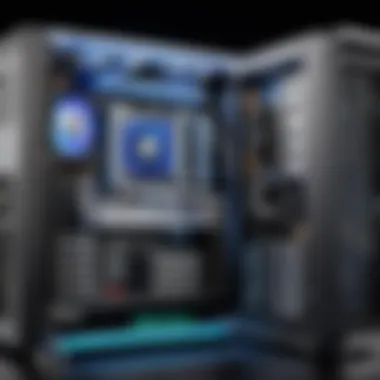
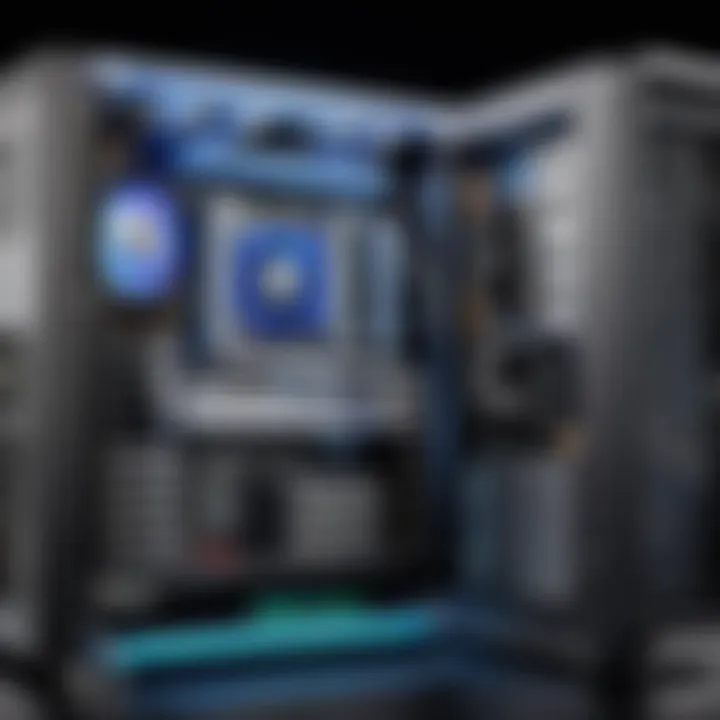
However, the unique aspect of efficiency's impact is the correlation it often has with system noise. Higher-rated power supplies frequently incorporate superior fan designs or even hybrid fan modes that minimize noise during less intensive tasks, which is particularly beneficial for gamers who prefer a quieter environment.
Choosing High-Efficiency Units
Selecting high-efficiency units goes beyond just looking at numbers; it involves a combination of value, performance, and reliability. These PSUs are generally built with better components, which contribute to their longer lifespan and stable output.
When shopping for a PSU, look beyond just the price tag. Consider the following:
- Long-term savings: Higher efficiency means lower electricity bills over time.
- Reduced heat emissions: Keeping your system cooler can have far-reaching benefits for component longevity.
- Quieter operation: Many high-efficiency PSUs include designs that help reduce noise.
Ultimately, investing in a PSU that boasts solid efficiency ratings is an investment in your entire gaming experience. Putting together the perfect gaming PC doesn’t end at the CPU or GPU; a well-chosen power supply stands as the backbone of a reliable, high-performance machine.
Future-Proofing Your Power Supply
In the rapidly evolving world of gaming technology, planning for the future can often feel like trying to hit a moving target. With components being upgraded every few years and new hardware setting the bar higher, ensuring that your power supply unit (PSU) can accommodate potential upgrades is of paramount importance. Future-proofing your PSU not only saves you from making additional investments in the short term but also ensures that your system meets your gaming ambitions as they grow and change.
Adopting a mindset that looks forward can be beneficial in multiple ways. For starters, it allows you to select a PSU that can support more demanding components should you decide to upgrade your CPU, GPU, or other peripherals. This foresight helps in avoiding a situation where a bottleneck in power delivery leads to subpar system performance, which could be quite frustrating during those critical gaming moments.
Considering Upgrade Possibilities
Anticipating Component Upgrades
Anticipating component upgrades is not just a good practice; it's vital for anyone looking to keep pace with gaming advancements. In a world where graphics resolution is going up and frame rates are increasingly essential, the components you have today may not cut it in just a couple of years.
One key characteristic of anticipating upgrades is recognizing how different components demand varying amounts of power. Gaming graphics cards, for instance, are notorious for their power spikes during intensive gaming sessions. Thus, a PSU that has breathing room—meaning it can deliver more wattage than what is currently consumed—can significantly enhance your system's viability long-term. Not only does this characteristic allow for component changes without the need for immediate PSU replacement, but it also ensures stability under load.
However, it's important to weigh the advantages against the disadvantages. While having an oversized PSU might seem like a safe route, it can also lead to lower efficiency ratings under minimal loads, resulting in wasted energy and increased utility costs.
Brand Recommendations for Scalability
When thinking about brand recommendations for scalability, one must consider the reputation and historical performance of different PSU manufacturers. Brands like Corsair, EVGA, and Seasonic have built trust with gamers and tech enthusiasts alike by creating modular power supplies that not only deliver robust performance but also allow for easy upgrades.
A significant feature of reputable brands is their commitment to quality assurance. They typically undergo rigorous testing to meet high standards, which speaks to their reliability over time. Such brands often include useful features for scalability, such as multiple 12V rails and a variety of connectors to accommodate future GPUs or CPUs.
The key characteristic of these brands also includes excellent warranty policies, which can offer peace of mind should you face unexpected failures. Yet, one must remain cautious as not all high-priced units guarantee premium performance. Selecting a well-reviewed PSU within your budget can often yield better results than going for the glitziest option out there.
Maintaining Power Supply Longevity
Maintaining the longevity of your power supply is crucial for ensuring that your gaming rig remains operational for years to come.
Temperature Management
One of the most important aspects in this regard is temperature management. High temperatures can degrade the internal components of a PSU over time, causing premature failure. This makes effective cooling solutions not only a benefit but a necessity for longevity.
Investing in a PSU with built-in thermal features, like fan controls or heat spreaders, can greatly reduce the risks associated with overheating. This type of management not only prolongs the unit's lifespan but ensures consistent power delivery under strain.
Of course, all components will require some form of temperature regulation, so it’s also wise to ensure good airflow within your entire case. A well-ventilated PC can prevent not just PSU issues, but can enhance the performance and longevity of every part therein, which ultimately leads toward your gaming goals.
Regular Testing
Regular testing is another significant aspect of maintaining power supply longevity. Many enthusiasts overlook the importance of periodically checking their PSU to ensure it operates within safe parameters. Tools available online can help measure voltage outputs and efficiency levels, keeping you informed of any drifts that could signal an impending failure.
This proactive approach can often save you from unexpected downtimes. Moreover, engaging in routine testing may help you identify any eventual need for upgrades, enabling smoother transitions when new components arrive.
Though testing requires some initial investment in equipment or software, it can lead to considerable savings over time by preventing costly hardware replacements due to premature PSU death
Final Thoughts
In summary, future-proofing your power supply is not merely a financial consideration; it is a comprehensive strategy to enhance your gaming experience. By keeping an eye on anticipated upgrades, being selective with your brand, managing heat effectively, and performing regular testing, you can ensure that your PSU will be a reliable partner in your gaming adventures.







